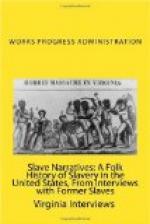“After the war was over, and my father, brother and uncle had gone to war, it left my mother alone practically. My mother had always been a cook, and that was all she knew, and after the war she got her freedom, she and me, I was seven or eight years old, and my brother was fourteen, and my sister was about sixteen. My mother didn’t know what to do, and I guess we looked kind of pitiful, finally my master said that we could stay and work for him a year, people worked by the year then. We stayed there that year, and then we also stayed there the following year, and he paid us the second year. After that we went to another place, Roof Macaroy, and then my sister got married while we were there, and then she moved on her husband’s master’s place, and then we went too. After that I moved on another part and farmed for two or three years, and then we moved to another part of the plantation and lived there three or four years. That was almost the center of things, and we held church there. All of the colored people would gather there. The colored people who had been in the North were better educated than the people in the South. They would come down to the South and help the rest of us. The white people would also try to promote religion among the colored people. Our church was a big log cabin. We lived in it, but we moved from one of the large rooms into a small one, so we could have church. I remember one time after we had been down on the creek bank fishing, that was what we always did on Sunday, because we didn’t know any better, my master called us boys and told us we should go to Sunday school instead of going fishing. I remember that to this day, and I have only been fishing one or two times since. Then I didn’t know what he was talking about, but two or three years later I learned what Sunday school was, and I started to go.”
“I went to a subscription school. We would all pay a man to come to teach us. I used to work for my room and board on Saturday’s, and go to school five days a week. That would have been all right, if I had kept it up, but I didn’t for very long, I learned to read and write pretty good though. There were no Government school then that were free.”
“We didn’t have a name. The slaves were always known by the master’s last name, and after we were freed we just took the last name of our masters and used it. After we had got our freedom papers, they had our ages and all on them, they were lost so we guess at our ages.”
“Most of the slave owners were good to their slaves although some of them were brutish of course.”
“In 1877 a lot of people began coming out here to Kansas, and in 1878 there were several, but in 1879 there were an awful lot of colored people immigrating. We came in 1877 to Kansas City, October 1. We landed about midnight. We came by train. Then there was nothing but little huts in the bottoms. The Santa Fe depot didn’t amount to anything. The Armours’ Packing house was even smaller than that. There was a swinging bridge over the river. The Kaw Valley was considered good-for-nothing, but to raise hemp. There was an awful lot of it grown there though, and there were also beavers in the Kaw River, and they used to cut down trees to build their dams. I worked several years and in 1880 I came to Franklin County.”




